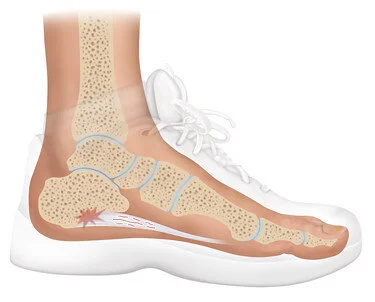All photography provided by Jared Chambers
Heal the root of your heel pain
What is plantar fasciitis?
Plantar fasciitis is a painful inflammatory condition of your plantar fascia. The plantar fascia is a dense connective tissue that runs from your heel across arch of your feet. Your calf muscles join it through the heel bone. They function together to support you in walking and running, especially in explosive movements and on hilly ground. Overuse or increased tension in your calf, ankle or foot can lead to inflammation and pain in your heel.
What does plantar fasciitis feel like?
Often times plantar fasciitis feels like a sharp pain in your heel just before the arch of your foot. It is typically most pronounced when you first wake up and put your foot down. It might be so unbearable that you doubt you can walk. Bu you will likely notice that it gets a little more bearable after a few more steps. This is because your calf tightens up when you sleep. As it loosens up and gets ready for your day, the symptoms improve a bit. After the early morning episode, you might experience an increase in symptom if calf muscles tighten up again such as during or after a long walk or long period of standing.
Why does it happen?
Humans are pretty much the only creature that walks on 2 legs all the time. Walking on 2 legs places much more pressure on one’s feet than walking on 4 legs like other animals. A lot of demand is placed on your calf and foot muscles. The plantar fascia joins these two muscle groups. The two muscles engage in a tug-o-war to stabilize your foot and ankle. If this process is imbalanced, or if a muscle is exhausted and tightens or cramps, the pressure on the plantar fascia may become too great.
Does plantar fascia heal?
It does! For some people, simply the pain of it that discourages them from walking or standing gives the tissue a chance to heal. But for some people, they may have experienced a condition that affected the flexibility or performance of their foot or calf muscles. Or other people may have demands in life that prevent them from getting the rest they need to let inflammation subside. Once these factors have been addressed, people typically make a full recovery and resume the activities they wish to do.
First step is to protect your heel while it rests. One aspect that many people can address is their footwear. Some footwear that may contribute to plantar fascia include:
flip flops or heelless sandals
0-drop or barefoot feel type shoes and flats
shoes with excessively stiff heels
Flip flops and heelless sandals cause your toes to spend too much effort gripping the floor and leads to tension placed on the plantar fascia. Flat bottomed shoes causes more stretch and demand on the calf muscles. Shoes with stiff heels don’t have as much shock absorption and may focus too much pressure onto your plantar fascia.
Custom foot orthotics made by a licensed orthotist can help distribute pressure on your foot more optimally. For some people, a simple rocker shoe may alleviate the pressure on the calf.
All of our leg muscles work together with our core muscles to balance us during 2 legged walking. Physical therapy can address challenges you have with calf tension, foot tension, muscle strength, and joint stiffness in your back, hip, or ankle that may contribute to your tendency to experience plantar fasciitis.
Your doctor may also help you with medication to facilitate the protection and recovery. Please speak with your physician about all your options.
What can we do to help?
We use a combination of physical therapy and holistic techniques to provide a natural, non-invasive way to improve the knee.
Yu Family Acupressure - A traditional technique to reduce pain and promote healing
Taping - Kinesiotape and other taping methods can help unload, support, and protect the heel. Placed appropriately they also encourage the proper muscle activity to help you use your foot and ankle better.
Mobilization & Stretching - Tension of your muscles and joint can place chronic & excessive tension on your plantar fascia. Hands on soft tissue and joint releases restore your knee’s optimal movement.
Exercises - Biases in your leg muscle strength (for instance, people may overuse their calf and foot to propel themselves forward to make up for deficits in hip propulsion strength), leads to overload of the plantar fascia. Stretching and strengthening exercises helps you to protect and improve your ankle between and beyond your physical therapy sessions.
There are many other methods and tools that are helpful, but the list would be exhausting. During your evaluation we will explain the the approach best for you in consideration with your needs and preferences.
Towel slide exercises can improve the strength of your arch and alleviate stress on your plantar fascia.
How long will it take?
Each visit lasts 45 mints to an hour. Adherence to your doctor and physical therapist’s advice on protecting your knee should prevent and alleviate your pain quickly. And you should start feeling better. Many people return to their activities after a few weeks or months of working on their knee.
How much does it cost?
We are in network with most PPO insurances and medicare. We also accept worker's compensation claims and automotive injury claims. You will be responsible for your insurance deductible and copay. We can contact your insurer to find out details for you but it is always recommended that you speak your your insurance company to verify as sometimes their database can be out of date.
Do you take insurance?
We are in network with most PPO insurances and medicare. We also accept worker's compensation claims and automotive injury claims. You will be responsible for your insurance deductible and copay. We can contact your insurer to find out details for you but it is always recommended that you speak your your insurance company to verify as sometimes their database can be out of date.
DOES the treatment hurt?
The treatment can cause discomfort comparable to a strong massage or a good workout. We aim to help you be and move comfortably again so we minimize discomfort whenever we can!
Are you sure this will work?
Most of our patients are able to return to living the life they wish without having to have surgery. Every person is different and we really need to get to know you and your condition to answer that question. If we feel that your condition would benefit from additional medical intervention beyond PT, we will happily refer you to a doctor who is right for you.
“Movement is life.”




